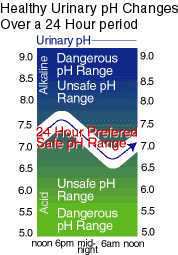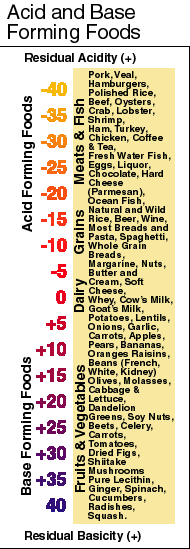|

 Växa's Buffer-pH+ is an Advanced Cardiovascular and Systemic
(body-wide) Nutraceutical Dietary Supplement which works to safely and
effectively balance an overly acid or overly alkaline system by buffering
overly acid and alkaline residues and removing them from your body, as well
as helping to dissolve toxic laden plaque. This allows tissues to be
cleansed, and then healed naturally and more quickly, by the body. Växa's Buffer-pH+ is an Advanced Cardiovascular and Systemic
(body-wide) Nutraceutical Dietary Supplement which works to safely and
effectively balance an overly acid or overly alkaline system by buffering
overly acid and alkaline residues and removing them from your body, as well
as helping to dissolve toxic laden plaque. This allows tissues to be
cleansed, and then healed naturally and more quickly, by the body.
The bulk of the American diet consists
of foods that leave an acidic residue within the body. This occurs when
food is metabolized and broken down, leaving certain chemical and metallic
residues which yield either acid or alkaline potentials of pH for the body.
It is these residues from our daily dietary choices that appear to most
strongly influence body pH levels. When the diet is imbalanced with an
excess of these acid or alkaline residues, which most western-world diets
are, body pH is directly and immediately impacted, causing body fluids to
lie constantly within the acidic range. And, just like acid rain upon a
forest, an imbalanced pH can slowly but steadily corrode your body and lead
to numerous health problems.
What Is "pH"?
The body is largely made up of
water, a medium which is biologically useful in allowing nutrients, oxygen
and biochemicals to be transported from place to place. This water-based
medium can have either acid or alkaline properties which are measured by a
graduated scale called pH (for "potential hydrogen"), wherein 1.0
to 6.9 is considered acidic, 7.0 is neutral, and 7.1 to 14.0 is alkaline.
The lower the pH number, the greater the acidity, and the higher the pH
number, the greater the alkalinity.
Why Should I Be Concerned About My pH
Levels?
Since most of the body is
water-based (making up 50-60% of our total body weight), the pH level has profound effects on all body chemistry, health and disease. An imbalanced
pH describes the pH level of the body when it becomes too acidic or too
alkaline for long periods of time. Extended pH imbalances of any kind are
not well tolerated by the body. Indeed, the management of "pH" is
so important that the body has developed strict accounting procedures to
monitor acid-alkaline balances in every cell. Fundamentally, all regulatory
mechanisms (including breathing, circulation, digestion, hormonal production,
etc.) serve the purpose of balancing pH, by removing caustic metabolized
acid residues from body tissues without damaging living cells. If the pH
deviates too far to the acid side or too far to the alkaline side, cells
become poisoned by their own toxic waste and die.
profound effects on all body chemistry, health and disease. An imbalanced
pH describes the pH level of the body when it becomes too acidic or too
alkaline for long periods of time. Extended pH imbalances of any kind are
not well tolerated by the body. Indeed, the management of "pH" is
so important that the body has developed strict accounting procedures to
monitor acid-alkaline balances in every cell. Fundamentally, all regulatory
mechanisms (including breathing, circulation, digestion, hormonal production,
etc.) serve the purpose of balancing pH, by removing caustic metabolized
acid residues from body tissues without damaging living cells. If the pH
deviates too far to the acid side or too far to the alkaline side, cells
become poisoned by their own toxic waste and die.
Is An Imbalanced Body pH Really That
Dangerous?
Yes, indeed it is! Nothing does
well in an overly acidic or alkaline pH medium, least of all the human
body! Just as acid rain can destroy a forest and alkaline wastes can
pollute a lake, an imbalanced pH continuously corrodes all body tissue,
slowly eating into the 60,000 miles of our veins and arteries like
corrosives eating into marble. If left unchecked, an imbalanced pH will
interrupt all cellular activities and functions, from the beating of your
heart to the neural firing of your brain... An imbalanced pH interferes
with all life itself!
Can An Imbalanced pH Cause Serious
Problems?
Yes, especially as a person
grows older! Although it may generally go unnoticed and undetected for years,
an imbalanced pH (either consistently too acid or alkaline) leads to the
progression of most, if not all, degenerative diseases including
Cardiovascular Disease (the #1 killer in the U.S.), Cancer (the #2 Killer
in the U.S.), and Diabetes, as well as the never ending frustration of
excessive systemic weight gain. The U.S. National Center for Health
Statistics estimates that if Cardiovascular Disease alone could be
eliminated, it would add an average of 9.78 years to our life span! That's
almost 10 years of additional life per person!
What Causes pH to
Become Imbalanced?
Most diets cause an unhealthy
Acid pH. In fact, diet appears to be the major influence in maintaining
appropriate pH levels throughout the body. Research demonstrates that when
food is metabolized and broken down, it leaves certain chemical and
metallic residues, a noncombustible "ash" which, when combined
with our body fluids, yields either acid or alkali potentials of pH.
Certain foods are "acid-forming" in nature, whereas others are known
to be "alkali-forming."
Which Foods Are
"Acid-Forming" And Which Ones Are "Alkaline-Forming"?
Most high protein foods (such as
meat, fish,  poultry and eggs), nearly all carbohydrates
(including grains, breads and pastas) and fats are "acid-forming."
And most fruits and vegetables are "alkaline-forming." Although
citrus fruits, such as oranges and grapefruit, contain organic acids and
may have an acid taste, they are not acid-forming when metabolized, leaving
no acidic residue. Similarly, Free Form Amino Acids are not acid-forming,
but instead offer unique buffering capabilities to the body to help offset
acidic wastes. poultry and eggs), nearly all carbohydrates
(including grains, breads and pastas) and fats are "acid-forming."
And most fruits and vegetables are "alkaline-forming." Although
citrus fruits, such as oranges and grapefruit, contain organic acids and
may have an acid taste, they are not acid-forming when metabolized, leaving
no acidic residue. Similarly, Free Form Amino Acids are not acid-forming,
but instead offer unique buffering capabilities to the body to help offset
acidic wastes.
How Can I Find Out My Body pH?
By testing your pH with Växa's Medical pH-Test Strips,
you can determine quickly and easily, in the privacy of your own home, what
your pH is. Växa Medical pH-Test Strips determine your urinary pH, which is
generally a good indicator of how acid or alkaline your total body pH is.
When urinary pH is continuously between 6.5 in the A.M. and 7.5 by evening,
you're functioning in a healthy range; When continuously above this range
you're too alkaline, and when continuously below it, you're too acid.
How Do I Rebalance My pH?
Watching your diet can help. If
you're too acid, increase the number of fruits and vegetables you eat. If
you're too alkaline, increase the amounts of acid-forming foods consumed.
But an easier way is to take Växa's Buffer-pH+ daily to help balance your
system while continuing to enjoy the foods you prefer!
How Does Växa's Buffer-pH+ Work?
Växa's Buffer-pH+ is an Advanced
Cardiovascular and Systemic (body-wide) Nutraceutical Dietary Supplement
which works to safely and effectively balance an overly acid or overly
alkaline system by buffering overly acid and alkaline residues and removing
them from your body, as well as helping to dissolve toxic laden plaque.
This allows tissues to be cleansed, and then healed naturally and more
quickly, by the body.
Selected References
Arieff, Allen I., and
DeFronzo, Ralph, A., (Editors) Fluid, Electrolyte and Acid-Base Disorders,
Churchill Livingstone, New York, NY, 1995.
Guton, Arthur C., and
Hall, John E., Textbook of Medical Physiology, Ninth Edition, W.B. Sanders
Company, Philadelphia, PA, 1996.
Heart and Stroke Facts:
1996 Statistical Supplement, American Heart Association, Washington D.C.,
1996.
Kannel, William B.,
D'Agostino, Ralph, B. and Cobb, James, L., Effect of Weight on
Cardiovascular Disease, American Journal of Clinical Nutrition, Volume 63,
March 1996.
Lang, F., Acid-Base
Metabolism, in Greger, R., and Windhorst, U., (Editors), Comprehensive
Human Physiology. Volume 1 & 2, Springer Publishing, New York and
Heidleberg, 1996.
Margolis, Simeon, and
Preziosi, Thomas J., Stroke, The Johns Hopkins White Papers, The Johns
Hopkins Medical Institutions, Baltimore, MD, 1996.
Margolis, Simeon, and
Priziosi, Thomas J., Coronary Heart Disease, The Johns Hopkins White
Papers, The Johns Hopkins Medical Institutions, Baltimore, MD, 1996.
Narins, Robert,
G.,Kupin, Warren, Faber, Mark, D., Goodkin, David, A., and Dunfee, Thomas,
P., Pathophysiology, Classification and Therapy of Acid-Base Disturbances,
in Arieff, Allen I., and DeFronzo, Ralph, A., (Editors) Fluid, Electrolyte
and Acid-Base Disorders, Churchill Livingstone, New York, NY 1995.
Wiley, Rudulf, A.,
BioBalance, The Acid/Alkaline Solution to the Food-Mood-Health Puzzle, Life
Sciences Press, Tacoma, WA, 1990.
Windhorst, U.,
Regulatory Principles in Physiology, in Greger, R., and Windhorst, U.,
(Editors), Comprehensive Human Physiology, Volume 1& 2, Springer
Publishing, New York and Heidlebert, 1996.
|